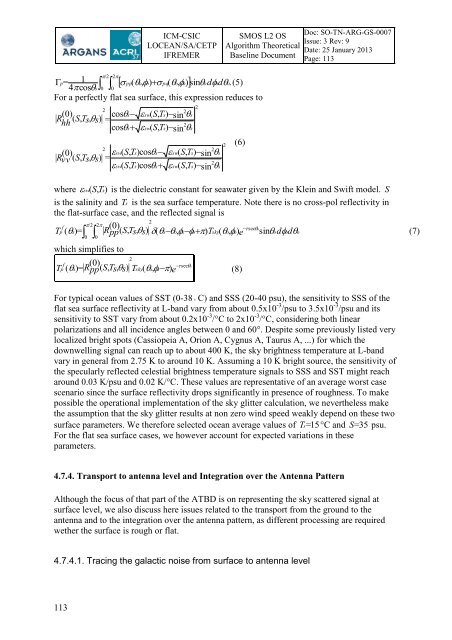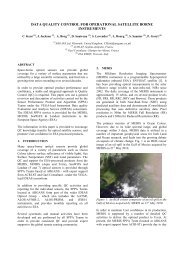SMOS L2 OS ATBD - ARGANS
SMOS L2 OS ATBD - ARGANS
SMOS L2 OS ATBD - ARGANS
Create successful ePaper yourself
Turn your PDF publications into a flip-book with our unique Google optimized e-Paper software.
113<br />
ICM-CSIC<br />
LOCEAN/SA/CETP<br />
IFREMER<br />
pp(<br />
o,<br />
o)<br />
<br />
pq(<br />
o,<br />
o)<br />
sin<br />
odo<br />
o.<br />
<strong>SM<strong>OS</strong></strong> <strong>L2</strong> <strong>OS</strong><br />
Algorithm Theoretical<br />
Baseline Document<br />
4 cos<br />
1<br />
/2<br />
2<br />
p= s<br />
0 0<br />
d (5)<br />
For a perfectly flat sea surface, this expression reduces to<br />
2<br />
2<br />
(0) coss<br />
sw(<br />
S,<br />
Ts)<br />
<br />
| ( , , ) | =<br />
sin s<br />
R<br />
hh<br />
S Ts<br />
s<br />
2<br />
coss<br />
sw(<br />
S,<br />
Ts)<br />
sin<br />
s<br />
2<br />
2<br />
(0) sw(<br />
S,<br />
Ts)<br />
coss<br />
sw(<br />
S,<br />
Ts)<br />
<br />
| ( , , ) | =<br />
sin s<br />
Rvv<br />
S Ts<br />
s<br />
2<br />
sw(<br />
S,<br />
Ts)<br />
coss<br />
sw(<br />
S,<br />
Ts)<br />
sin<br />
s<br />
2<br />
2<br />
(6)<br />
Doc: SO-TN-ARG-GS-0007<br />
Issue: 3 Rev: 9<br />
Date: 25 January 2013<br />
Page: 113<br />
where sw( S,<br />
Ts)<br />
is the dielectric constant for seawater given by the Klein and Swift model. S<br />
is the salinity and T s is the sea surface temperature. Note there is no cross-pol reflectivity in<br />
the flat-surface case, and the reflected signal is<br />
2<br />
f<br />
/2<br />
2<br />
(0)<br />
<br />
seco<br />
Tp ( s)<br />
= | Rpp(<br />
S,<br />
Ts,<br />
s)<br />
| (<br />
so,<br />
s<br />
o)<br />
Tsky(<br />
o,<br />
o)<br />
e sin<br />
odod<br />
o<br />
<br />
(7)<br />
0<br />
which simplifies to<br />
0<br />
2<br />
f (0)<br />
<br />
sec<br />
s<br />
Tp<br />
( s)<br />
= | Rpp(<br />
S,<br />
Ts,<br />
s)<br />
| Tsky(<br />
s,<br />
s<br />
)<br />
e<br />
(8)<br />
For typical ocean values of SST (0-38 C) and SSS (20-40 psu), the sensitivity to SSS of the<br />
flat sea surface reflectivity at L-band vary from about 0.5x10 -3 /psu to 3.5x10 -3 /psu and its<br />
sensitivity to SST vary from about 0.2x10 -3 /°C to 2x10 -3 /°C, considering both linear<br />
polarizations and all incidence angles between 0 and 60°. Despite some previously listed very<br />
localized bright spots (Cassiopeia A, Orion A, Cygnus A, Taurus A, ...) for which the<br />
downwelling signal can reach up to about 400 K, the sky brightness temperature at L-band<br />
vary in general from 2.75 K to around 10 K. Assuming a 10 K bright source, the sensitivity of<br />
the specularly reflected celestial brightness temperature signals to SSS and SST might reach<br />
around 0.03 K/psu and 0.02 K/°C. These values are representative of an average worst case<br />
scenario since the surface reflectivity drops significantly in presence of roughness. To make<br />
possible the operational implementation of the sky glitter calculation, we nevertheless make<br />
the assumption that the sky glitter results at non zero wind speed weakly depend on these two<br />
surface parameters. We therefore selected ocean average values of T s=<br />
15°C<br />
and S = 35 psu.<br />
For the flat sea surface cases, we however account for expected variations in these<br />
parameters.<br />
4.7.4. Transport to antenna level and Integration over the Antenna Pattern<br />
Although the focus of that part of the <strong>ATBD</strong> is on representing the sky scattered signal at<br />
surface level, we also discuss here issues related to the transport from the ground to the<br />
antenna and to the integration over the antenna pattern, as different processing are required<br />
wether the surface is rough or flat.<br />
4.7.4.1. Tracing the galactic noise from surface to antenna level



